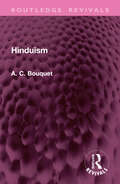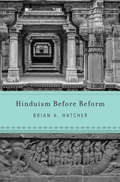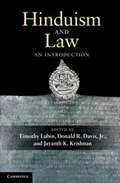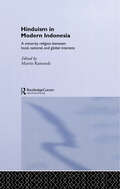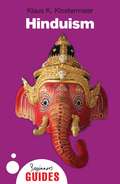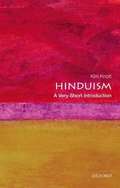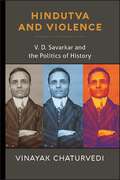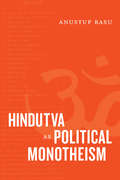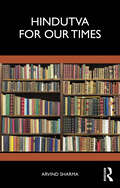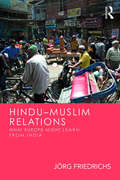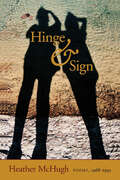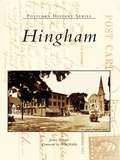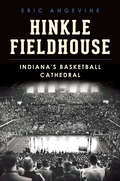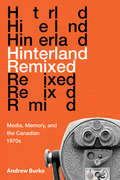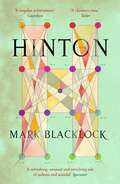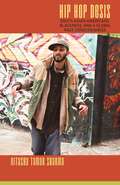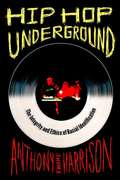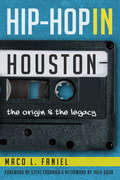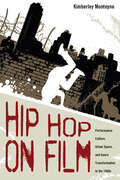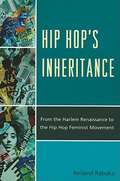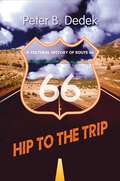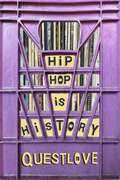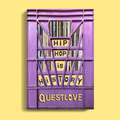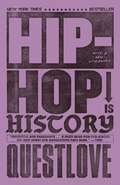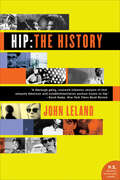- Table View
- List View
Hinduism (Routledge Revivals)
by A. C. BouquetFirst published in 1948, Hinduism presents an introductory outline of the story of Hinduism from the earliest times, and paves the way for further and more detailed study, as well as interests the general reader. It intends to exhibit Hinduism as an event rather than as something static; as an organism, developing, reforming itself, and even changing and absorbing new elements, rather than as a rigid creed, or even as a survival from the past. This book will be of interest to students of religion, history and South Asian studies.
Hinduism Before Reform
by Brian A. HatcherHow did Hindu reformers make the religion modern? Brian Hatcher argues that this is the wrong question to ask. Exploring two nineteenth-century Hindu movements, the Brahmo Samaj and the Swaminarayan Sampraday, he challenges the notion of religious reform.
Hinduism and Law: An Introduction
by Donald R. Davis Jr. Timothy Lubin Jayanth K. KrishnanCovering the earliest Sanskrit rulebooks through to the codification of 'Hindu law' in modern times, this interdisciplinary volume examines the interactions between Hinduism and the law. The authors present the major transformations to India's legal system in both the colonial and post colonial periods and their relation to recent changes in Hinduism. Thematic studies show how law and Hinduism relate and interact in areas such as ritual, logic, politics, and literature, offering a broad coverage of South Asia's contributions to religion and law at the intersection of society, politics and culture. In doing so, the authors build on previous treatments of Hindu law as a purely text-based tradition, and in the process, provide a fascinating account of an often neglected social and political history.
Hinduism in Modern Indonesia
by Martin RamstedtThis book provides new data and perspectives on the development of 'world religion' in post-colonial societies through an analysis of the development of 'Hinduism' in various parts of Indonesia from the early twentieth century to the present. This development has been largely driven by the religious and cultural policy of the Indonesian central government, although the process began during the colonial period as an indigenous response to the introduction of modernity.
Hinduism: A Beginner's Guide
by Klaus K. KlostermaierIn this introduction to Hinduism, Klaus K. Klostermaier explains the origins, beliefs, scriptures and philosophies of this ancient religion, and considers modern challenges the religion faces, such as the relationship between Hinduism and the West. The book offers a unique overview of a tradition that spans thousands of years and is essential reading for students, followers, and interested readers alike.
Hinduism: A Very Short Introduction
by Kim KnottIs Hinduism one religion or many different religions each defined by region, caste, and sect? Is it a religion at all? Does it make us think about the subject of religion in new ways? Although it is quite impossible to answer all these questions satisfactorily, by discussing them we are able to appreciate the extraordinary complexity, diversity, and dynamism of all that we call Hinduism.
Hindutva and Violence: V. D. Savarkar and the Politics of History
by Vinayak ChaturvediExamines the place of history in the political thought of Vinayak Damodar Savarkar, one of the key architects of modern Hindu nationalism.Hindutva and Violence explores the place of history in the political thought of Vinayak Damodar Savarkar (1883–1966), the most controversial Indian political thinker of the twentieth century and a key architect of Hindu nationalism. Examining his central claim that "Hindutva is not a word but a history," the book argues that, for Savarkar, this history was not a total history, a complete history, or a narrative history. Rather, its purpose was to trace key historical events to a powerful source-the font of motivation for "chief actors" of the past who had turned to violence in a permanent war for Hindutva as the founding principle of a Hindu nation. At the center of Savarkar's writings are historical characters who not only participated in ethical warfare against invaders, imperialists, and conquerors in India, but also became Hindus in acts of violence. He argues that the discipline of history provides the only method for interpreting Hindutva.The book also shows how Savarkar developed his conceptualization of history as a way into the meaning of Hindutva. Savarkar wrote extensively, from analyses of the nineteenth century to studies of antiquity, to draw up his histories of Hindus. He also turned to a wide range of works, from the epic tradition to contemporary social theory and world history, as his way of explicating "Hindutva" and "history." By examining Savarkar's key writings on history, historical methodology, and historiography, Vinayak Chaturvedi provides an interpretation of the philosophical underpinnings of Hindutva. Savarkar's interpretation of Hindutva, he demonstrates, requires above all grappling with his idea of history.
Hindutva as Political Monotheism
by Anustup BasuIn Hindutva as Political Monotheism, Anustup Basu offers a genealogical study of Hindutva—Hindu right-wing nationalism—to illustrate the significance of Western anthropology and political theory to the idea of India as a Hindu nation. Connecting Nazi jurist Carl Schmitt's notion of political theology to traditional theorems of Hindu sovereignty and nationhood, Basu demonstrates how Western and Indian theorists subsumed a vast array of polytheistic, pantheistic, and henotheistic cults featuring millions of gods into a singular edifice of faith. Basu exposes the purported “Hindu Nation” as itself an orientalist vision by analyzing three crucial moments: European anthropologists’ and Indian intellectuals’ invention of a unified Hinduism during the long nineteenth century; Indian ideologues’ adoption of ethnoreligious nationalism in pursuit of a single Hindu way of life in the twentieth century; and the transformations of this project in the era of finance capital, Bollywood, and new media. Arguing that Hindutva aligns with Enlightenment notions of nationalism, Basu foregrounds its significance not just to Narendra Modi's right-wing, anti-Muslim government but also to mainstream Indian nationalism and its credo of secularism and tolerance.
Hindutva for Our Times
by Arvind SharmaThis book studies Hindu nationalism and deliberates on the forms Hindu self-assertion might take in the future. It examines the intersection of Hindu nationalism with the contemporary reality of India, as represented by a religiously plural society with a secular state, which possesses a social system characterised by caste, and one whose vision has been shaped by a mainstream version of Indian history. The ideology of Hindutva has had two major orientations—of how Hindus should relate to each other, and how Hindus should relate to the followers of other religions. The author provides a new orientation to both these dimensions of Hindutva ideology.A unique contribution, this book will be an essential read for scholars and researchers of religion studies, history, postcolonialism, nationalism, pluralism, Indian political thought, Indian history, caste studies, political science, Hindu studies, Hindusim, sociology and political ideology, and South Asian studies.
Hindu–Muslim Relations: What Europe Might Learn from India
by Jörg FriedrichsThis book reconstructs Hindu–Muslim relations from a European standpoint. Drawing from the Indian context, the author explores options for Western Europe – a region grappling with the refugee crisis and populist reactions to the growth of Muslim minorities. The author shows how India can serve not only as a model but also as a warning for Europe. For example, European liberals may learn not only from the achievements of Indian secularism but also from its crisis. Based on extensive interviews with Indians from diverse backgrounds, from politicians to social activists and from the middle class to slum dwellers, the volume investigates a wide range of perspectives: Hindu and Muslim, religious and secular, moderate and militant. Relevant, engaging and accessible, this book speaks to a broad audience of concerned citizens and policy makers. Scholars of political science, sociology, modern history, cultural studies and South Asian studies will be particularly interested.
Hinge & Sign: Poems, 1968–1993 (Wesleyan Poetry Series)
by Heather McHughA renowned poet's artful collection is a striking body of work.
Hingham (Postcard History)
by Scott Wahle James PierottiThe established neighborhoods of Hingham make up a seashore community that has retained much of its historic charm. The Old Derby Academy, Old Ordinary Tavern, and the Old Ship Meetinghouse church are all local treasures. Atrip down Main Street affords extraordinary views of fine Victorian homes and Colonial farmhouses. Hingham was also home to the U.S. armed forces buildup during World Wars I and II. This Colonial settlement truly remains a celebrated all-American town.
Hinkle Fieldhouse: Indiana's Basketball Cathedral (Landmarks)
by Eric AngevineWalk into Hinkle Fieldhouse, and you feel it--that palpable sense of history known as the Hinkle mystique. Indiana's basketball cathedral has stood in all its glory at Butler University since 1928. John Wooden, Oscar Robertson and Larry Bird played on its floor. Jesse Owens sprinted to a record at Hinkle, and athletes from around the globe have brought Olympic-level competition to crowds gathered under its steel arches. It was the setting for the climactic scene in Hoosiers, arguably the greatest sports movie ever made. It has hosted evangelists, ice shows, tennis matches, bike races and even roller derbies. Author Eric Angevine gets inside the paint in this complete Hinkle history, featuring archival photographs of the iconic structure and words from those who know it best.
Hinterland Remixed: Media, Memory, and the Canadian 1970s
by Andrew BurkeLike the flute melody from Hinterland Who's Who, the 1970s haunt Canadian cultural memory. Though the decade often feels lost to history, Hinterland Remixed focuses on boldly innovative works as well as popular film, television, and music to show that Canada never fully left the 1970s behind. Andrew Burke reveals how contemporary artists and filmmakers have revisited the era's cinematic and televisual residues to uncover what has been lost over the years. Investigating how the traces of an analogue past circulate in a digital age, Burke digs through the remnants of 1970s Canadiana and examines key audiovisual works from this overlooked decade, uncovering the period's aspirations, desires, fears, and anxieties. He then looks to contemporary projects that remix, remediate, and reanimate the period. Exploring an idiosyncratic selection of works – from Michael Snow's experimental landscape film La Région Centrale, to SCTV's satirical skewering of network television, to L'Atelier national du Manitoba's video lament for the Winnipeg Jets – this book asks key questions about nation, nostalgia, media, and memory. A timely intervention, Hinterland Remixed demands we recognize the ways in which the unrealized cultural ambitions and unresolved anxieties of a previous decade continue to resonate in our current lives.
Hinton
by Mark BlacklockA nineteenth-century tale of dangerous and pioneering ideas, based on the incredible true story of a scandalous British mathematician.Howard Hinton and his family are living in Japan, escaping from a scandal. Hinton&’s obsession is his work, his voyages into mathematical pure space, into the fourth dimension, but also his wife and sons, each of whom are entangled in the strange and unknown landscapes of Hinton&’s science fictions.In a bravura and startling meeting of real and philosophical elements, Mark Blacklock has created a ravishing period piece of late-Victorian social, scientific and domestic life. Hinton is about extraordinary discoveries, and terrible choices. It is about people who discover and map other realms, and what the implications might be for those of us left behind.&“A singular literary achievement.&” —TheObserver&“A refreshing, unusual and enriching tale of sadness and scandal.&” —Spectator &“Somewhere between detective novel, philosophical head-scratcher and historical page-turner, Hinton is a chimerical treat.&” —Tatler&“A brilliant resurrectionist raid on the past as it should have unfolded. Mark Blacklock breathes new life into the tropes of detective fiction, occult mathematics and forensic science. He makes new mysteries out of re-forgotten enigmas.&” —Iain Sinclair
Hip Hop Desis: South Asian Americans, Blackness, and a Global Race Consciousness
by Nitasha Tamar SharmaHip Hop Desis explores the aesthetics and politics of South Asian American (desi) hip hop artists. Nitasha Tamar Sharma argues that through their lives and lyrics, young "hip hop desis" express a global race consciousness that reflects both their sense of connection with Blacks as racialized minorities in the United States and their diasporic sensibility as part of a global community of South Asians. She emphasizes the role of appropriation and sampling in the ways that hip hop desis craft their identities, create art, and pursue social activism. Some desi artists produce what she calls "ethnic hip hop," incorporating South Asian languages, instruments, and immigrant themes. Through ethnic hip hop, artists, including KB, Sammy, and Deejay Bella, express "alternative desiness," challenging assumptions about their identities as South Asians, children of immigrants, minorities, and Americans. Hip hop desis also contest and seek to bridge perceived divisions between Blacks and South Asian Americans. By taking up themes considered irrelevant to many Asian Americans, desi performers, such as D'Lo, Chee Malabar of Himalayan Project, and Rawj of Feenom Circle, create a multiracial form of Black popular culture to fight racism and enact social change.
Hip Hop Underground: The Integrity and Ethics of Racial Identification
by Harrison Anthony KwameRace and authenticity in America, explored through the Bay Area's multiracial underground hip hop scene
Hip Hop in Houston: The Origin and the Legacy
by Julie Grub Maco L. Faniel Steve FournierRap-A-Lot Records, U.G.K. (Pimp C and Bun B), Paul Wall, Beyonce, Chamillionaire and Scarface are all names synonymous with contemporary hip-hop. And they have one thing in common: Houston. Long before the country came to know the chopped and screwed style of rap from the Bayou City in the late 1990s, hip-hop in Houston grew steadily and produced some of the most prolific independent artists in the industry. With early roots in jazz, blues, R&B and zydeco, Houston hip-hop evolved not only as a musical form but also as a cultural movement. Join Maco L. Faniel as he uncovers the early years of Houston hip-hop from the music to the culture it inspired.
Hip Hop on Film: Performance Culture, Urban Space, and Genre Transformation in the 1980s
by Kimberley MonteyneEarly hip hop film musicals have either been expunged from cinema history or excoriated in brief passages by critics and other writers. Hip Hop on Film reclaims and reexamines productions such as Breakin' (1984), Beat Street (1984), and Krush Groove (1985) in order to illuminate Hollywood's fascinating efforts to incorporate this nascent urban culture into conventional narrative forms. Such films presented musical conventions against the backdrop of graffiti-splattered trains and abandoned tenements in urban communities of color, setting the stage for radical social and political transformations. Hip hop musicals are also part of the broader history of teen cinema, and films such as Charlie Ahearn's Wild Style (1983) are here examined alongside other contemporary youth-oriented productions. As suburban teen films banished parents and children to the margins of narrative action, hip hop musicals, by contrast, presented inclusive and unconventional filial groupings that included all members of the neighborhood. These alternative social configurations directly referenced specific urban social problems, which affected the stability of inner-city families following diminished governmental assistance in communities of color during the 1980s. Breakdancing, a central element of hip hop musicals, is also reconsidered. It gained widespread acclaim at the same time that these films entered the theaters, but the nation's newly discovered dance form was embattled—caught between a multitude of institutional entities such as the ballet academy, advertising culture, and dance publications that vied to control its meaning, particularly in relation to delineations of gender. As street-trained breakers were enticed to join the world of professional ballet, this newly forged relationship was recast by dance promoters as a way to invigorate and “remasculinize” European dance, while young women simultaneously critiqued conventional masculinities through an appropriation of breakdance. These multiple and volatile histories influenced the first wave of hip hop films, and even structured the sleeper hit Flashdance (1983). This forgotten, ignored, and maligned cinema is not only an important aspect of hip hop history, but is also central to the histories of teen film, the postclassical musical, and even institutional dance. Kimberley Monteyne places these films within the wider context of their cultural antecedents and reconsiders the genre's influence.
Hip Hop's Inheritance: From The Harlem Renaissance To The Hip Hop Feminist Movement
by Reiland RabakaHip Hop's Inheritance arguably offers the first book-length treatment of what hip hop culture has, literally, 'inherited' from the Harlem Renaissance, the Black Arts movement, the Feminist Art movement, and 1980s and 1990s postmodern aesthetics. By comparing and contrasting the major motifs of the aforementioned cultural aesthetic traditions with those of hip hop culture, all the while critically exploring the origins and evolution of black popular culture from antebellum America through to "Obama's America," Hip Hop's Inheritance demonstrates that the hip hop generation is not the first generation of young black (and white) folk preoccupied with spirituality and sexuality, race and religion, entertainment and athletics, or ghetto culture and bourgeois culture. Taking interdisciplinarity and intersectionality seriously, Hip Hop's Inheritance employs the epistemologies and methodologies from a wide range of academic and organic intellectual/activist communities in its efforts to advance an intellectual history and critical theory of hip hop culture. Drawing from academic and organic intellectual/activist communities as diverse as African American studies and women's studies, postcolonial studies and sexuality studies, history and philosophy, politics and economics, and sociology and ethnomusicology, Hip Hop's Inheritance calls into question one-dimensional and monodisciplinary interpretations or, rather, misinterpretations, of a multidimensional and multivalent form of popular culture that has increasingly come to include cultural criticism, social commentary, and political analysis.
Hip to the Trip: A Cultural History of Route 66
by Peter B. DedekBefore and since its official closure in 1985, historic U.S. 66 became associated with the deserts, Indians, and cowboys of the Southwest, the Okies of the Great Depression, and the millions of vacationers who took to the highway in their streamlined automobiles and found adventure on the open road from the late 1940s to the 1970s. Route 66 has such name recognition that in the past twenty years it has been used to advertise products ranging from blue jeans, to root beer, to automobiles.The highway enjoyed only about thirty years of dominance as a primary auto and truck route from 1926 to around 1956. Gradually replaced by interstates into the 1980s, Route 66 became forever fixed in the history and lore of the Southwest and the United States. Route 66 provides a unique vantage point from which to better understand American popular culture from the 1920s to the present. The purpose of this book is not to simply recount the history of Route 66, but to create a comprehensive portrait of the cultural meaning of the highway. What was Route 66 at its pinnacle, what is it today, and what might it become in the future?
Hip-Hop Is History
by Ben Greenman QuestloveA must-read for old-school hip-hop heads and burgeoning fans alikeTime'Hip Hip is not History, it's Our story. Brilliant book'Craig Charles'Hip-Hop Is History melds a detailed chronological retelling of the genre's story with occasionally hair-raising memoir 'Guardian'Sharp and lyrical analyses of hip-hop's evolution with fascinating, up-close recollections of the genre's turning point... an exuberant account of a dynamic musical genre and the cultural climate in which it evolved Publishers WeeklyWhen hip-hop first emerged in the 1970s, it wasn't expected to become the cultural force it is today. But for a young Black kid growing up in a musical family in Philadelphia, it was everything. He stayed up late to hear the newest songs on the radio. He saved his money to buy vinyl as soon as it landed. He even started to try to make his own songs. That kid was Questlove, and decades later, he is a six-time Grammy Award-winning musician, an Academy Award-winning filmmaker, a New York Times bestselling author, a producer, an entrepreneur, a cofounder of one of hip-hop's defining acts (the Roots), and the genre's unofficial in-house historian. In this landmark book, Hip-Hop Is History, Questlove skilfully traces the creative and cultural forces that made and shaped hip-hop, highlighting both the forgotten but influential gems and the undeniable chart-topping hits-and weaves it all together with the stories no one else knows. It is at once an intimate, sharply observed story of a cultural revolution and a sweeping, grand theory of the evolution of the great artistic movement of our time. And Questlove, of course, approaches it with not only the encyclopaedic fluency and passion of an obsessive fan but also the expertise and originality of an innovative participant. Hip-hop is history, and also his history.'A must-read for music lovers, cultural history buffs, and hip-hop fans... Questlove's illuminating and insightful survey is as personal as it is expert'Booklist'A memorable, masterful history of the first 50 years of an indelible American art form'Kirkus ReviewsThe musician and Oscar-winning director traces the first 50 years of hip-hop... Questlove pairs the history of hip-hop with a personal reflection on how the genre shaped his identity during his childhood in PhiladelphiaThe Week
Hip-Hop Is History
by Ben Greenman QuestloveA must-read for old-school hip-hop heads and burgeoning fans alikeTime'Hip Hip is not History, it's Our story. Brilliant book'Craig Charles'Hip-Hop Is History melds a detailed chronological retelling of the genre's story with occasionally hair-raising memoir 'Guardian'Sharp and lyrical analyses of hip-hop's evolution with fascinating, up-close recollections of the genre's turning point... an exuberant account of a dynamic musical genre and the cultural climate in which it evolved Publishers WeeklyWhen hip-hop first emerged in the 1970s, it wasn't expected to become the cultural force it is today. But for a young Black kid growing up in a musical family in Philadelphia, it was everything. He stayed up late to hear the newest songs on the radio. He saved his money to buy vinyl as soon as it landed. He even started to try to make his own songs. That kid was Questlove, and decades later, he is a six-time Grammy Award-winning musician, an Academy Award-winning filmmaker, a New York Times bestselling author, a producer, an entrepreneur, a cofounder of one of hip-hop's defining acts (the Roots), and the genre's unofficial in-house historian. In this landmark book, Hip-Hop Is History, Questlove skilfully traces the creative and cultural forces that made and shaped hip-hop, highlighting both the forgotten but influential gems and the undeniable chart-topping hits-and weaves it all together with the stories no one else knows. It is at once an intimate, sharply observed story of a cultural revolution and a sweeping, grand theory of the evolution of the great artistic movement of our time. And Questlove, of course, approaches it with not only the encyclopaedic fluency and passion of an obsessive fan but also the expertise and originality of an innovative participant. Hip-hop is history, and also his history.'A must-read for music lovers, cultural history buffs, and hip-hop fans... Questlove's illuminating and insightful survey is as personal as it is expert'Booklist'A memorable, masterful history of the first 50 years of an indelible American art form'Kirkus ReviewsThe musician and Oscar-winning director traces the first 50 years of hip-hop... Questlove pairs the history of hip-hop with a personal reflection on how the genre shaped his identity during his childhood in PhiladelphiaThe Week
Hip-Hop Is History
by QuestloveThis is a book only Questlove could have written: a perceptive and personal reflection on the first half-century of hip-hop.When hip-hop first emerged in the 1970s, it wasn't expected to become the cultural force it is today. But for a young Black kid growing up in a musical family in Philadelphia, it was everything. He stayed up late to hear the newest songs on the radio. He saved his money to buy vinyl as soon as it landed. He even started to make his own songs. That kid was Questlove. Now, in this landmark book, Questlove traces the creative and cultural forces that made and shaped hip-hop, highlighting both the forgotten but influential gems and the undeniable chart-topping hits-and weaves it all together with the stories no one else knows. It is at once an intimate, sharply observed story and a sweeping theory of the evolution of the great artistic movement of our time. Questlove approaches it with both the encyclopedic fluency of an obsessive fan and the unique expertise of an innovative participant. Hip-hop is history, and also his history.
Hip: The History
by John LelandHip: The History is the story of how American pop culture has evolved throughout the twentieth century to its current position as world cultural touchstone. How did hip become such an obsession? From sex and music to fashion and commerce, John Leland tracks the arc of ideas as they move from subterranean Bohemia to Madison Avenue and back again. Hip: The History examines how hip has helped shape -- and continues to influence -- America's view of itself, and provides an incisive account of hip's quest for authenticity.This P.S. edition features an extra 16 pages of insights into the book, including author interviews, recommended reading, and more.
